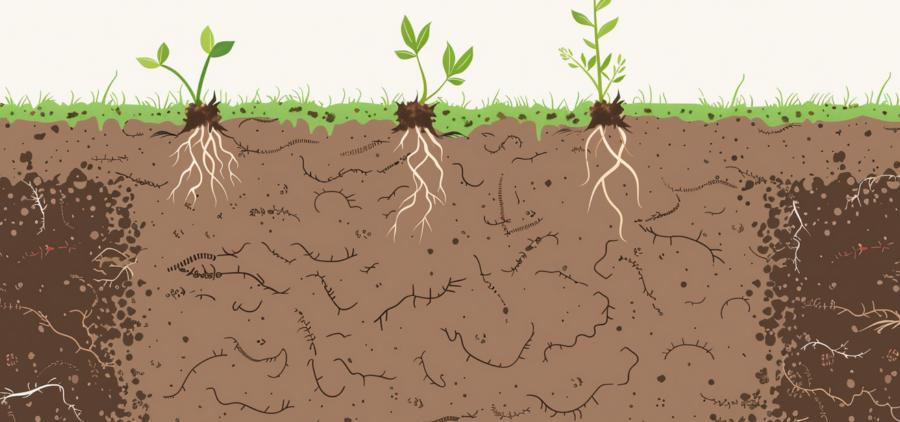When gardeners talk about “good soil,” they’re often unknowingly praising the silent labor of earthworms. These subterranean engineers reshape soil structure through tunneling, improve nutrient distribution, and leave behind tiny packages of fertility wherever they go. It’s a full-service operation with zero overhead.
Tunnels That Breathe
The first and most obvious contribution of earthworms is their burrowing. These tunnels aren’t just aimless meandering—they create critical macropores (large air and water channels) that dramatically improve soil aeration and drainage. Compacted soil is essentially a no-go zone for plant roots and beneficial microbes. Worms, through sheer persistence and appetite, punch airways back into it.Well-aerated soil means more oxygen for roots and microbes, less anaerobic decomposition, and better root penetration. In heavy clay, worms are often the difference between struggling seedlings and thriving vegetables. Their tunnels serve as root expressways.
Drainage Without the Drama
Anyone who’s tried gardening after a long rain knows what a soggy mess poor drainage creates. Waterlogged soils choke roots and create ideal conditions for rot and root pathogens. Worms help prevent this by opening up escape routes for water.Their tunnels act as vertical drains, particularly in loamy or clay-heavy soils, allowing excess water to percolate down instead of sitting around and ruining your tomatoes’ weekend plans. Better drainage reduces erosion risk and surface runoff, keeping nutrients where they belong: in the root zone.
Casts With Benefits
Worms aren’t just glorified dirt plumbers. Their real superpower lies in what they leave behind. Earthworm castings—essentially their manure—are small, rich pellets loaded with bioavailable nutrients and microbial life. Unlike raw organic matter, castings are already processed, stabilized, and immediately usable by plants.Nutrient-wise, castings tend to have an NPK ratio around 1-0.5-0.8. That may seem modest, but their magic lies in balance and bioavailability. They’re gentle enough not to burn plants, yet rich enough to support strong growth. Castings also contain humic acids, which improve nutrient retention in the soil and stimulate plant enzymes.
They also have a crumbly texture that helps maintain soil tilth—a fancy word for that nice, loose, easy-to-work structure gardeners love but rarely achieve. Unless they know a guy who knows a worm.
The Mineral Mixers
Beyond nutrients and structure, worms act as bioturbators—a term that sounds illegal but just means they mix different layers of soil. As they consume organic matter on the surface and deposit castings deeper in the profile, worms help cycle minerals throughout the root zone. It’s like nutrient redistribution with none of the paperwork.This mineralization process improves the availability of micronutrients like calcium, magnesium, and iron. These are often overlooked in quick-fix fertilizers but are crucial to plant development. Worms ensure these elements don’t stay locked away in stubborn subsoil or inaccessible clumps.
Soil Structure That Holds Its Shape
A well-structured soil resists erosion, drains efficiently, and holds onto nutrients like it actually wants your garden to succeed. Earthworms contribute to this by binding soil particles together with mucus and microbial activity, forming stable aggregates. These aggregates are like the building blocks of healthy soil—clumpy enough to let water and air through, yet stable enough not to collapse into dust or sludge.Worm activity also counteracts surface crusting, which can block seed germination and lead to runoff. Instead of a hardpan deathtrap, you get a welcoming, textured soil that roots can explore freely. And if you’ve ever pulled up a carrot and found it forked around a compacted patch, you’ll appreciate what a difference that makes.
Getting Worms to Work for You
Attracting earthworms to your soil isn’t complicated, but it does require a little hospitality. They prefer moist, dark, and organically rich environments—so skip the tilling frenzy and synthetic fertilizers. Tillage slices up worm tunnels like a blender set to “annoy,” and chemicals disrupt the delicate microbe balance worms rely on.Here’s how to make your garden worm-friendly:
- Add compost or aged manure regularly to provide steady food sources
- Mulch with leaves, straw, or wood chips to retain moisture and temperature
- Avoid pesticides and synthetic fertilizers that can harm worms and their microbial allies
- Water deeply and infrequently to maintain ideal conditions below the surface
Not All Worms Wear the Same Boots
There are different types of earthworms, and not all are equally suited to every task. For example, composting worms like Eisenia fetida are surface dwellers that thrive in organic-rich layers, but they won’t tunnel deeply. You want endogeic or anecic species for true soil engineering.Anecic worms like Lumbricus terrestris (nightcrawlers) dig permanent vertical burrows and come to the surface to drag organic matter down—a behavior that improves deep soil fertility and mixes materials between layers. They’re the long-haul truckers of the worm world.
Endogeic worms stay within the soil, mixing minerals and organic matter horizontally. They’re great for structure and density, especially in more compacted soils.
Wriggle While You Work
Whether you’re growing vegetables, fruit trees, or trying to coax a lawn back from the brink, earthworms are one of your best silent partners. Their presence correlates strongly with higher organic matter, improved crop yields, and greater soil biodiversity. They don’t just live in the soil—they reshape it, every single day.Adding worms is not a shortcut; it’s a system-level upgrade. And the beauty is, once they’re there and happy, they reproduce and expand their influence naturally. No battery required. No warranty issues.
Tunnel Vision
If your soil is dead, compacted, or just plain grumpy, you don’t need a bulldozer or a chemistry set. You need worms. They tunnel not just through dirt, but through the barriers that stand between a failing garden and a flourishing one. Their trails, their castings, their microbial passengers—they all speak to a version of gardening that’s less interventionist and more collaborative.Earthworms don’t just improve soil. They transform it from the inside out, digging passageways to oxygen, water, and fertility like quiet revolutionaries in slow motion.
So yes—get some worms. Let them handle the underground economy. They’ve been doing it longer than any of us have been around to take credit for it.
Article kindly provided by The Worm Hub


